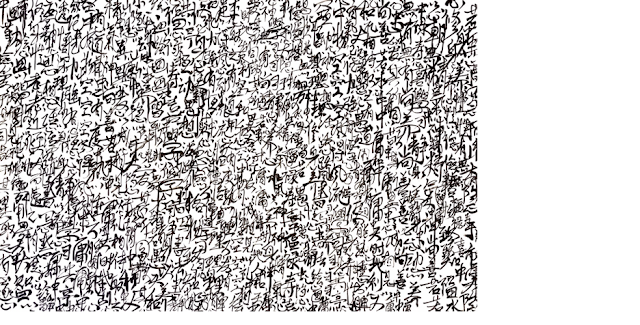满 (Man / Fullness), 2019
满 (Man / Fullness), 2019
Chinese Ink on Rice Paper, 68 × 45 cm
At first glance, the work overwhelms with its density. Characters cascade and compress into one another until legibility becomes a sea of fragments. Out of this sea, one discerns the large character 满 — “full” — almost buried, its horns protruding above the surface like mountain peaks above a surging tide of script.
text by Hamamoto Satoshi + Choo Meng Foo
This tension — the character for fullness submerged in an excess of words — defines the work’s conceptual paradox. On the one hand, fullness is desired: to be filled with knowledge, culture, wisdom, is the aspiration of both scholar and sage. Yet fullness is also danger. A cup filled to the brim can contain no more; it becomes static, stagnant. As Laozi cautions in the Dao De Jing:
“持而盈之,不如其已;揣而锐之,不可长保。”
(“Fill it to the brim, and it will spill;
Keep sharpening the blade, and it will blunt.”)
In this sense, the painting becomes a meditation on the Daoist logic of emptiness: only through emptiness can one remain receptive; only through yielding softness can one continue to grow. Bruce Lee, in his famous dictum echoing Daoist and Chan wisdom, reminds us:
“Be like water, my friend. Empty your mind.
Be formless, shapeless, like water.
You put water into a cup, it becomes the cup.
You put water into a bottle, it becomes the bottle.
You put it in a teapot, it becomes the teapot.
Water can flow or it can crash. Be water, my friend.”
The sea of script in this painting visually recalls water — fluid, unstoppable, without fixed shape — yet paradoxically “full.” The viewer feels the weight of language, but also its dissolution into pure movement.
Among the fragments, words like 自 (“self”) repeat insistently, hinting at the path of self-cultivation. To avoid the arrogance of fullness is to return to the work of inner cultivation — a reminder that learning is not accumulation but transformation. Within the overwhelming field of ink, the viewer glimpses scattered words like flotsam, fragments of wisdom rising from a wasteland.
This recalls T. S. Eliot’s The Waste Land, where amidst ruin and fragmentation, the poet searches for renewal:
“These fragments I have shored against my ruins.”
Like Eliot’s fragments, the scattered characters in this work demand contemplation. The sea of “waste” is not merely loss but potential; hidden within it are the gems of thought that point toward renewal and clarity.
Visually, the large “满” teeters on the edge of legibility. Psychologically, it stages the tension between wanting to be complete and fearing that completeness may be death. The work dramatizes this paradox: fullness suffocates, while emptiness breathes.
Ultimately, 满 is not a statement but a question. The viewer must ask: when am I full, and when am I open? What do I seek to contain, and what must I let flow away? The artwork becomes a mirror of the mind, a reminder that wisdom does not lie in holding, but in letting go.
Short Exhibition Text
满 (Man / Fullness), 2019 (Sold)
Chinese Ink on Rice Paper. Size: 68cm x 45cm
In this work, the character 满 (fullness) emerges half-buried in a sea of words, its horns rising above the tide of script. Fullness here is both aspiration and danger: a cup too full can no longer receive, just as a mind too certain ceases to grow.
The sea of ink recalls water — flowing, fluid, without fixed form — echoing Bruce Lee’s famous words: “Be like water, my friend… Water can flow, or it can crash.”
Amidst the fragments, words like 自 (“self”) repeat, hinting at self-cultivation. Like Eliot’s The Waste Land, the piece suggests that from fragments and excess, meaning can still be found.
The work reminds us: only in emptiness can one remain open, receptive, alive.



Comments
Post a Comment